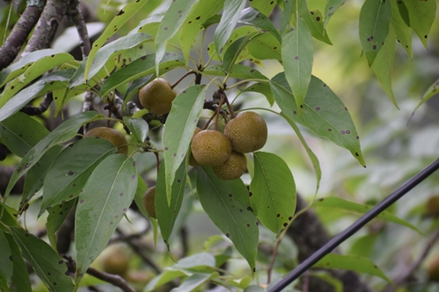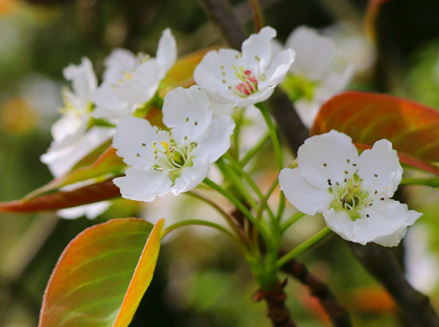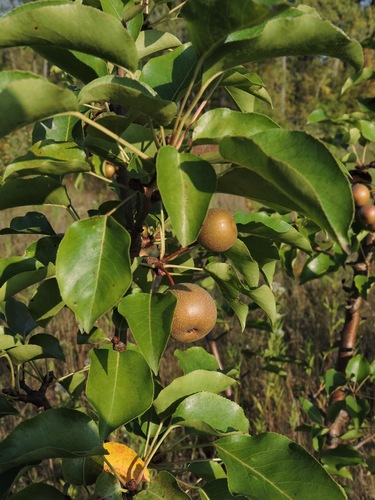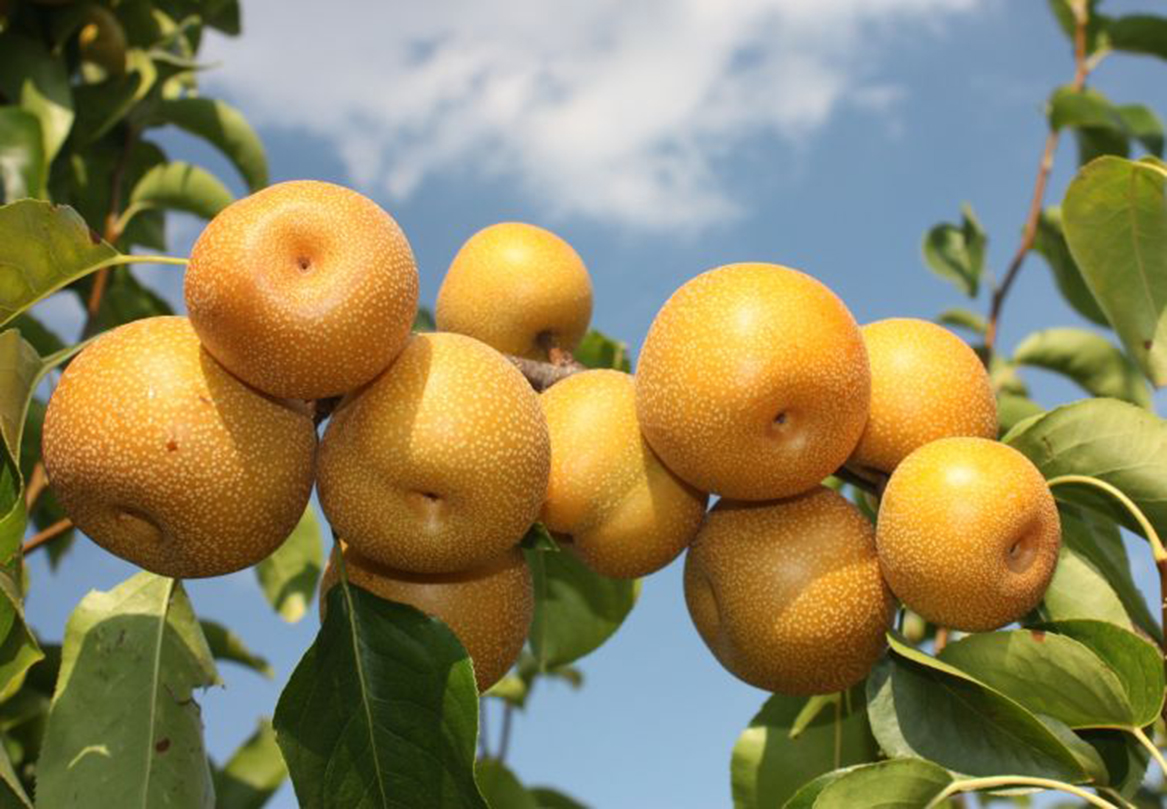ເລກລຳດັບທີ: 1719
ລະດັບການຮວບຮວມຂໍ້ມູນ: ຂໍ້ມູນພື້ນຖານ
ປັບປູງຄັ້ງລ່າສຸດ: 2025-01-30
ໝາກຈອງ
Asian Pear
Pyrus pyrifolia (Burm.f.) Nakai
ພືດ
ໄມ້ຢືນຕົ້ນ
ຕົ້ນໄມ້ ແລະ ປາມ
×
ຊື່ທ້ອງຖີ່ນ:
( Japanese pear, oriental pear, nashi pear)
ຊື່ພ້ອງ
:
Ficus pyrifolia Burm.fil.
Malus quinqueflora (Buch.-Ham. ex D.Don) M.Roem.
Pyrus arakiana Koidz.
Pyrus asakeensis Koidz.
Pyrus autumnalis (Siebold) Koidz.
Pyrus autumnalis f. discolor (Nakai) Koidz.
Pyrus autumnalis f. hiemalis (Siebold) Koidz.
Pyrus autumnalis f. pallescens (Nakai) Koidz.
Pyrus autumnalis f. sieboldii Koidz.
Pyrus autumnalis var. culta (Makino) Koidz.
Pyrus babauttiagi Koidz.
Pyrus communis var. autumnalis Siebold
Pyrus communis var. hiemalis Siebold
Pyrus communis var. sinensis K.Koch
Pyrus cuneata Koidz.
Pyrus higoensis Koidz.
Pyrus incubacea Koidz.
Pyrus kiushiana Koidz.
Pyrus kiusiana Koidz.
Pyrus kleinhofiana Koidz.
Pyrus lakuhokuensis Koidz.
Pyrus lasiogyna Koidz.
Pyrus lasiogyna var. lanuginosa Nakai
Pyrus lindleyi Rehder
Pyrus malus var. sinensis (K.Koch) Wenz.
Pyrus montana Nakai
Pyrus montana var. rehderi Nakai
Pyrus nehiyamadonis Koidz.
Pyrus pseudocalleryana Uyeki
Pyrus pseudouipongensis Uyeki
Pyrus pyrifolia f. discolor Nakai
Pyrus pyrifolia f. hiemalis (Siebold) Nakai
Pyrus pyrifolia f. pallescens Nakai
Pyrus pyrifolia f. stapfiana (Rehder) Rehder
Pyrus pyrifolia var. culta (Makino) Nakai
Pyrus pyrifolia var. montana (Nakai) Nakai
Pyrus pyrifolia var. pyrifolia
Pyrus pyrifolia var. talyschensis Gladkova
Pyrus quinqueflora Buch.-Ham.
Pyrus quinqueflora Buch.-Ham. ex G.Don
Pyrus saidaeana Koidz.
Pyrus serotina Rehder
Pyrus serotina var. culta (Makino) Rehder
Pyrus serotina var. stapfiana Rehder
Pyrus sinensis L.H.Bailey
Pyrus sinensis Lindl.
Pyrus sinensis var. culta Makino
Pyrus sohayakiensis Koidz.
Pyrus tajimaensis Koidz.
Pyrus takuhokuensis Koidz. & Acta Phytotax.Geobot.
Pyrus tambana Koidz.
Pyrus tobishimensis Koidz.
Pyrus tobisimensis Koidz.
Pyrus togashiana Koidz.
Pyrus tsuchiyana Koidz.
Pyrus tungusiana Koidz.
Pyrus uipongensis Uyeki
Pyrus umemurana Koidz.
Pyrus yohrohensis Koidz.
Malus quinqueflora (Buch.-Ham. ex D.Don) M.Roem.
Pyrus arakiana Koidz.
Pyrus asakeensis Koidz.
Pyrus autumnalis (Siebold) Koidz.
Pyrus autumnalis f. discolor (Nakai) Koidz.
Pyrus autumnalis f. hiemalis (Siebold) Koidz.
Pyrus autumnalis f. pallescens (Nakai) Koidz.
Pyrus autumnalis f. sieboldii Koidz.
Pyrus autumnalis var. culta (Makino) Koidz.
Pyrus babauttiagi Koidz.
Pyrus communis var. autumnalis Siebold
Pyrus communis var. hiemalis Siebold
Pyrus communis var. sinensis K.Koch
Pyrus cuneata Koidz.
Pyrus higoensis Koidz.
Pyrus incubacea Koidz.
Pyrus kiushiana Koidz.
Pyrus kiusiana Koidz.
Pyrus kleinhofiana Koidz.
Pyrus lakuhokuensis Koidz.
Pyrus lasiogyna Koidz.
Pyrus lasiogyna var. lanuginosa Nakai
Pyrus lindleyi Rehder
Pyrus malus var. sinensis (K.Koch) Wenz.
Pyrus montana Nakai
Pyrus montana var. rehderi Nakai
Pyrus nehiyamadonis Koidz.
Pyrus pseudocalleryana Uyeki
Pyrus pseudouipongensis Uyeki
Pyrus pyrifolia f. discolor Nakai
Pyrus pyrifolia f. hiemalis (Siebold) Nakai
Pyrus pyrifolia f. pallescens Nakai
Pyrus pyrifolia f. stapfiana (Rehder) Rehder
Pyrus pyrifolia var. culta (Makino) Nakai
Pyrus pyrifolia var. montana (Nakai) Nakai
Pyrus pyrifolia var. pyrifolia
Pyrus pyrifolia var. talyschensis Gladkova
Pyrus quinqueflora Buch.-Ham.
Pyrus quinqueflora Buch.-Ham. ex G.Don
Pyrus saidaeana Koidz.
Pyrus serotina Rehder
Pyrus serotina var. culta (Makino) Rehder
Pyrus serotina var. stapfiana Rehder
Pyrus sinensis L.H.Bailey
Pyrus sinensis Lindl.
Pyrus sinensis var. culta Makino
Pyrus sohayakiensis Koidz.
Pyrus tajimaensis Koidz.
Pyrus takuhokuensis Koidz. & Acta Phytotax.Geobot.
Pyrus tambana Koidz.
Pyrus tobishimensis Koidz.
Pyrus tobisimensis Koidz.
Pyrus togashiana Koidz.
Pyrus tsuchiyana Koidz.
Pyrus tungusiana Koidz.
Pyrus uipongensis Uyeki
Pyrus umemurana Koidz.
Pyrus yohrohensis Koidz.
ຊື່ສະກຸນ:
Rosaceae
ຊະນິດໃກ້ຄຽງ:
ໝາກເລີງ / Lao Crabapple
ໝາກຄາຍ/ Peach
ຕົ້ນໝາກເຖື່ອນ (ຊາກຸຣະເມືອງລາວ)/ Sour cherry
ໝາກຄາຍ/ Peach
ຕົ້ນໝາກເຖື່ອນ (ຊາກຸຣະເມືອງລາວ)/ Sour cherry
ບັນຍາຍລັກສະນະທາງພືດສາດ:
ຕົ້ນໝາກຈອງເປັນໄມ້ຢືນຕົ້ນຕັ້ງຊື່, ໂດຍປົກກະຕິຈະສູງ 7 ຫາ15 ມ. ແຕກກິ່ງກ້ານ ບາງ ແລະ ອາດເປັນສີນ້ຳຕານເຂັ້ມ ຫຼື ສີນ້ຳຕານປົນສີມ່ວງ, ຜິວຈະຄ່ອຍລຽບຂື້ນເມື່ອແກ່ເຕັມທີ, ກິ່ງອ່ອນ ມີຂົນສີນ້ຳຕານປົກຄຸມຢູ່ທົ່ວ.
ໃບໝາກຈອງມີລັກສະນະໜາ, ຂອບໃບມີຂົນອ່ອນ ແລະ ບໍລິເວນຖານໃບມີຫູໃບຍາວ 1 ຫາ 1.5 ຊມ, ມີລັກສະນະເປັນເສັ້ນຊື່, ໃບຍາວ 7 ຫາ 12 ຊມ ແລະ ກວ້າງ 4 ຫາ 6.5 ຊມ. ໃບຮູບຮີ ຫຼື ຮູບຂອບຂະໜານ ແລະ ເມື່ອຍັງອ່ອນຈະມີຂົນສີນ້ຳຕານປົກຄຸມບາງໆ, ໂຄນໃບໂຄ້ງມົນ ຫຼື ເປັນຮູບຫົວໃຈ, ຂອບເປັນແສກແຂ້ວ.
ຊໍ່ດອກສັ້ນ ແລະ ເປັນກະຈຸກ, ມີລັກສະນະເປັນຊໍ່ດ່ຽວ, ກ້ານຊໍ່ດອກສັ້ນ. ດອກຍ່ອຍມີ 6 ຫາ 9 ດອກ, ສີຂາວ, ຖານຮອງດອກເປັນຮູບຖ້ວຍ, ດອກມີຂະໜາດເສັ້ນຜ່າສູນກາງປະມານ 2.5 ຫາ 3.5 ຊມ ແລະ ປະກອບດ້ວຍກາບດອກ 5 ກາບ, ກີບດອກມີ 5 ກີບ, ເກສອນເພດຜູ້ 20 ອັນ, ເຕົ້າໄຂ່ 4 ຫາ 5 ອັນ.
ໝາກຈອງມີລັກສະນະກົມ ຫຼື ລັກສະນະຄ້າຍໝາກຄາຍ, ມີເສັ້ນຜ່າສູນກາງປະມານ 2 ຫາ 2.5 ຊມ. ມີສີນ້ຳຕານ ແລະ ມີຈຸດສີເທົາອ່ອນ ແລະ ມີກ້ານຍາວ3.5 ຊມ ຫາ 5.5 ຊມ. [1]
ໃບໝາກຈອງມີລັກສະນະໜາ, ຂອບໃບມີຂົນອ່ອນ ແລະ ບໍລິເວນຖານໃບມີຫູໃບຍາວ 1 ຫາ 1.5 ຊມ, ມີລັກສະນະເປັນເສັ້ນຊື່, ໃບຍາວ 7 ຫາ 12 ຊມ ແລະ ກວ້າງ 4 ຫາ 6.5 ຊມ. ໃບຮູບຮີ ຫຼື ຮູບຂອບຂະໜານ ແລະ ເມື່ອຍັງອ່ອນຈະມີຂົນສີນ້ຳຕານປົກຄຸມບາງໆ, ໂຄນໃບໂຄ້ງມົນ ຫຼື ເປັນຮູບຫົວໃຈ, ຂອບເປັນແສກແຂ້ວ.
ຊໍ່ດອກສັ້ນ ແລະ ເປັນກະຈຸກ, ມີລັກສະນະເປັນຊໍ່ດ່ຽວ, ກ້ານຊໍ່ດອກສັ້ນ. ດອກຍ່ອຍມີ 6 ຫາ 9 ດອກ, ສີຂາວ, ຖານຮອງດອກເປັນຮູບຖ້ວຍ, ດອກມີຂະໜາດເສັ້ນຜ່າສູນກາງປະມານ 2.5 ຫາ 3.5 ຊມ ແລະ ປະກອບດ້ວຍກາບດອກ 5 ກາບ, ກີບດອກມີ 5 ກີບ, ເກສອນເພດຜູ້ 20 ອັນ, ເຕົ້າໄຂ່ 4 ຫາ 5 ອັນ.
ໝາກຈອງມີລັກສະນະກົມ ຫຼື ລັກສະນະຄ້າຍໝາກຄາຍ, ມີເສັ້ນຜ່າສູນກາງປະມານ 2 ຫາ 2.5 ຊມ. ມີສີນ້ຳຕານ ແລະ ມີຈຸດສີເທົາອ່ອນ ແລະ ມີກ້ານຍາວ3.5 ຊມ ຫາ 5.5 ຊມ. [1]
ນິເວດວິທະຍາ
ເຂດກະຈາຍພັນທົ່ວໂລກ:
Native to China South-Central, China Southeast, Laos, Vietnam. [6]
ຊະນິດພັນພື້ນເມືອງຂອງ ພາກໃຕ້ ແລະ ພາກຕາເວັນອອກຊຽງໃຕ້ຂອງຈີນ, ລາວ ແລະ ຫວຽດນາມ. [6]
Source: [2]
ແຫຼ່ງທີ່ມາ: [2]
ຊະນິດພັນພື້ນເມືອງຂອງ ພາກໃຕ້ ແລະ ພາກຕາເວັນອອກຊຽງໃຕ້ຂອງຈີນ, ລາວ ແລະ ຫວຽດນາມ. [6]
Source: [2]
ແຫຼ່ງທີ່ມາ: [2]
ເຂດກະຈາຍພັນໃນລາວ
:
ເຂດພູສູງພາກເໜືອຂອງລາວ
ເຂດພູສູງສາຍພູຫຼວງ ແລະ ເຂດພູພຽງແຂວງຊຽງຂວາງ
ເຂດສາຍພູຫຼວງພາກເໜືອ
ເຂດພູສູງສາຍພູຫຼວງ ແລະ ເຂດພູພຽງແຂວງຊຽງຂວາງ
ເຂດສາຍພູຫຼວງພາກເໜືອ

ເຂດກະຈາຍພັນຕາມພູມສັນຖານ
:
ປ່າປູກ
ປ່າເຫຼົ່າອ່ອນ
ປ່າເຫຼົ່າແກ່
ປ່າເຫຼົ່າອ່ອນ
ປ່າເຫຼົ່າແກ່
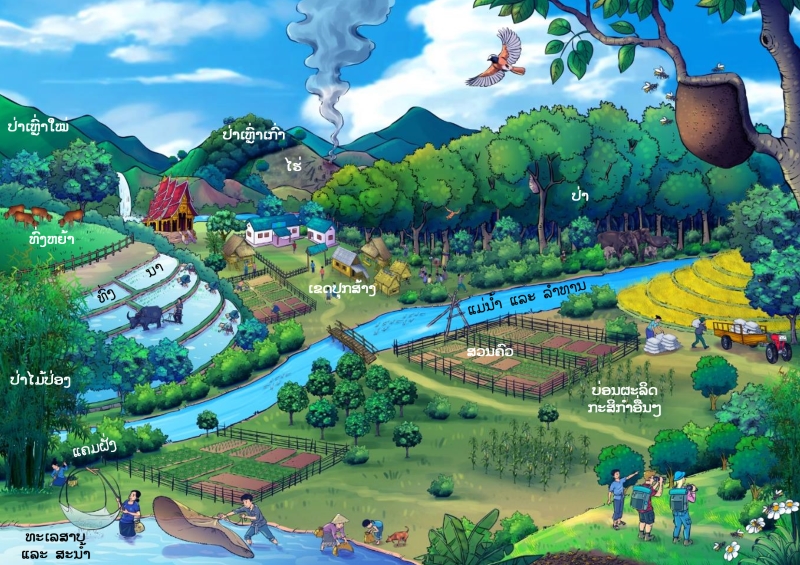
ສະເພາະຖິ່ນໃນລາວ:
ພື້ນເມືອງ
ຮຸກຮານ
:
ບໍ່ຮຸກຮານ
ສະຖານະພາບການອະນູຮັກ IUCN
:
ບໍ່ມີຄວາມສ່ຽງ
ສະຖານະພາບການອະນຸຮັກແຫ່ງຊາດລາວ
:
ບໍ່ຖືກລະບຸໃນບັນຊີປະເພດໃດ
ການນຳໃຊ້
ປະເພດການນຳໃຊ້:
ອາຫານ
ພືດເປັນຢາ
ພືດເປັນຢາ
ບັນຍາຍການນຳໃຊ້:
ອາຫານ: ໝາກມີເນື້ອສີຂາວ ກອບ ແລະ ອົມນ້ຳ ສາມາດຮັບປະທານໄດ້, ມີລົດຊາດຫວານປົນສົ້ມເລັກຫນ້ອຍ, ໝາກເມື່ອສຸກເຕັມທີ່ແລ້ວ ຈະມີເນື້ອແໜ້ນ, ກອບ ແລະ ອົມນໍ້າ ຈຶ່ງ ເໝາະສົມຫຼັບການຮັບປະທານສົດ ຫຼື ໃສ່ໃນຍໍາໝາກໄມ້ ແລະ ເຮັດເຂົ້າໜົມໄດ້. [4], [5]
ສະໝຸນໄພ: ໃຊ້ເປັນຢາຂ້າເຊື້ອ (ປ້ອງກັນ ຫຼື ສະລໍການເຕີບໂຕຂອງຈຸລິນຊີ ໃຊ້ເພື່ອປ້ອງກັນການຕິດເຊື້ອ), ໃຊ້ເປັນຢາຝາດ (ເຮັດໃຫ້ແພຈຸລັງຂອງຮ່າງກາຍຫົດຕົວ, ມັກໃຊ້ເພື່ອຫ້າມເລືອດ ຫຼື ກະຊັບຜິວໜັງ), ໃຊ້ເປັນຢາຫຼຸດໄຂ້, ຢາແກ້ປະສາດ (ເຮັດໃຫ້ປະສາດສະຫງົບ ຫຼື ຫຼຸດຄວາມຕຶງຄຽດຂອງລະບົບປະສາດ) ແລະ ໃຊ້ເປັນຢາແກ້ອາການເຈັບເອິກ ( ເຊິ່ງຈະມັກໃຊ້ກ່ຽວກັບບັນຫາລະບົບທາງເດີນຫາຍໃຈ), [5]
ສະໝຸນໄພ: ໃຊ້ເປັນຢາຂ້າເຊື້ອ (ປ້ອງກັນ ຫຼື ສະລໍການເຕີບໂຕຂອງຈຸລິນຊີ ໃຊ້ເພື່ອປ້ອງກັນການຕິດເຊື້ອ), ໃຊ້ເປັນຢາຝາດ (ເຮັດໃຫ້ແພຈຸລັງຂອງຮ່າງກາຍຫົດຕົວ, ມັກໃຊ້ເພື່ອຫ້າມເລືອດ ຫຼື ກະຊັບຜິວໜັງ), ໃຊ້ເປັນຢາຫຼຸດໄຂ້, ຢາແກ້ປະສາດ (ເຮັດໃຫ້ປະສາດສະຫງົບ ຫຼື ຫຼຸດຄວາມຕຶງຄຽດຂອງລະບົບປະສາດ) ແລະ ໃຊ້ເປັນຢາແກ້ອາການເຈັບເອິກ ( ເຊິ່ງຈະມັກໃຊ້ກ່ຽວກັບບັນຫາລະບົບທາງເດີນຫາຍໃຈ), [5]
ການປູກ ການລ້ຽງ:
ປູກ ແລະ ທຳມະຊາດ
ລະດູການເກັບກູ້:
ເມສາ
ພຶກສະພາ
ມິຖຸນາ
ກໍລະກົດ
ສິງຫາ
ພຶກສະພາ
ມິຖຸນາ
ກໍລະກົດ
ສິງຫາ
ການຕະຫຼາດ ແລະ ຕ່ອງໂສ້ມູນຄ່າ:
N/A
ການຄຸ້ມຄອງຈັດການ
N/A
ໂພຊະນາການ
ຄຸນຄ່າທາງໂພຊະນາການ:
ບັນຍາຍຄຸນຄ່າທາງໂພຊະນາການ:
N/A
| ສານອາຫານ | /100g | ໝາຍເຫດ |
|---|---|---|
| ໂປຣຕີນ | N/A | N/A |
| ຄາໂບໄຮເດຣດ | N/A | N/A |
| ໄຂມັນ | N/A | N/A |
| ວິຕາມິນ | N/A | N/A |
| ແຮ່ທາດ | N/A | N/A |
| ເສັ້ນໄຍ | N/A | N/A |
ອ້າງອິງ
ເຄດິດຮູບພາບ:
Asian Pear tree with fruit. [1] iNaturalist [Online]. Uploaded on 05 September 2019 by: aniruddha_singhamahapatra. Available: www.inaturalist.org/photos/50474232. [Accessed: 18 September 2024]
Flowers from the Pyrus pyrifolia tree. [2] Nabu Naturgucker [Online]. Uploaded on 27 April 2018 by: Rainer Mönke. Available: https://nabu-naturgucker.de/natur.dll/E3Hfn4hnFwwHGGHjLZJJlgRKFJW/#ad-image-NGID1669304915. [Accessed: 18 September 2024]
Asian Pear, up close view. [3] Nabu Naturgucker [Online]. Uploaded on 28 July 2018 by: Rainer Mönke. Available: https://nabu-naturgucker.de/natur.dll/YZepm6nxZZkMy8ziLFA-ZCpHpOG/. [Accessed: 18 September 2024]
Flowers from the Pyrus pyrifolia tree. [2] Nabu Naturgucker [Online]. Uploaded on 27 April 2018 by: Rainer Mönke. Available: https://nabu-naturgucker.de/natur.dll/E3Hfn4hnFwwHGGHjLZJJlgRKFJW/#ad-image-NGID1669304915. [Accessed: 18 September 2024]
Asian Pear, up close view. [3] Nabu Naturgucker [Online]. Uploaded on 28 July 2018 by: Rainer Mönke. Available: https://nabu-naturgucker.de/natur.dll/YZepm6nxZZkMy8ziLFA-ZCpHpOG/. [Accessed: 18 September 2024]
ອ້າງອິງ:
[1] Korban, S., “Compendium of Plant Genomes”, Switzerland: Uni-versity of Illinois at Urbana-Champaign, 2019.
[2] Global Biodiversity Information Facility (GBIF), “Species record: [5362786]” [Online]. Available: https://www.gbif.org/species/5362786. [Accessed: 17 Sep-tember 2024]
[3] IUCN, “IUCN Red List,” [Online]. Available: https://www.iucnredlist.org/search?query=Radermachera%20ignea&searchType=species. [Accessed: 06 March 2024]
[4] C. Reed, "Import risk analysis: Pears (Pyrus bretschneideri, Pyrus pyrifolia, and Pyrus sp. nr. communis) fresh fruit from China final," Ministry of Agriculture and Forestry, China, 2009.
[5] Nakai, "Plants for a Future." [Online]. Available: https://pfaf.org/user/Plant.aspx?LatinName=Pyrus+pyrifolia. [Accessed: 08 August 2024].
[6] "Pyrus pyrifolia (Burm.f.) Nakai," Kew Science, 2024. [Online].
Available: https://powo.science.kew.org/taxon/urn:lsid:ipni.org:names:731158-1. [Accessed: Jan. 9, 2025].
[2] Global Biodiversity Information Facility (GBIF), “Species record: [5362786]” [Online]. Available: https://www.gbif.org/species/5362786. [Accessed: 17 Sep-tember 2024]
[3] IUCN, “IUCN Red List,” [Online]. Available: https://www.iucnredlist.org/search?query=Radermachera%20ignea&searchType=species. [Accessed: 06 March 2024]
[4] C. Reed, "Import risk analysis: Pears (Pyrus bretschneideri, Pyrus pyrifolia, and Pyrus sp. nr. communis) fresh fruit from China final," Ministry of Agriculture and Forestry, China, 2009.
[5] Nakai, "Plants for a Future." [Online]. Available: https://pfaf.org/user/Plant.aspx?LatinName=Pyrus+pyrifolia. [Accessed: 08 August 2024].
[6] "Pyrus pyrifolia (Burm.f.) Nakai," Kew Science, 2024. [Online].
Available: https://powo.science.kew.org/taxon/urn:lsid:ipni.org:names:731158-1. [Accessed: Jan. 9, 2025].
ຜູ້ສ້າງ Factsheet:
ຜູ້ກວດສອບ Factsheet:
Daniela Barcelo, Biologists
